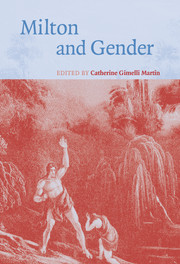Book contents
- Frontmatter
- Contents
- List of illustrations
- Notes on contributors
- Acknowledgments
- Abbreviations
- Introduction: Milton's gendered subjects
- PART I MASCULINITY, DIVORCE, AND MISOGYNY IN MILTON'S PROSE
- PART II THE GENDERED SUBJECTS OF MILTON'S MAJOR POEMS
- PART III GENDERED SUBJECTIVITY IN MILTON'S LITERARY HISTORY
- Index
Introduction: Milton's gendered subjects
Published online by Cambridge University Press: 22 September 2009
- Frontmatter
- Contents
- List of illustrations
- Notes on contributors
- Acknowledgments
- Abbreviations
- Introduction: Milton's gendered subjects
- PART I MASCULINITY, DIVORCE, AND MISOGYNY IN MILTON'S PROSE
- PART II THE GENDERED SUBJECTS OF MILTON'S MAJOR POEMS
- PART III GENDERED SUBJECTIVITY IN MILTON'S LITERARY HISTORY
- Index
Summary
Milton's treatment of women, marriage, and divorce in his life and works has been subject to criticism almost as long as his major works themselves. Ever since Samuel Johnson's famous Life of the poet, the charge that the great advocate of mutuality in marriage bore a “Turkish contempt” for women has survived, and, in the twentieth century, actually thrived. Yet this claim would no doubt have astonished both the poet himself and his contemporaries, the most critical of whom regarded his views on women and marriage as libertine, not retrograde. As Ruth Mohl points out, the poet's early Commonplace Book also disproves “Milton's proverbial disesteem for women.” Its many laudatory remarks upon the “weaker sex” include tributes to such admirable women as Queen Elizabeth, Tasso's heroine Sophronia, Lady Scroope, the wife of Edward I, Queen Martia, and the Countesse of Arundel. Even more significantly, these tributes characteristically counterbalance the “less complimentary … contentions of those writers who would discredit women altogether” (CPW 1:357). Yet then as now, these attitudes have proved far less controversial than his defense of divorce “at pleasure.” His contemporaries considered this thesis no less scandalous than his defense of regicide: at worst, he was the spokesman of the radical new sect of divorcers; at best, his new notion of marriage as a spiritual rather than a physical bond seemed ludicrously utopian.
- Type
- Chapter
- Information
- Milton and Gender , pp. 1 - 16Publisher: Cambridge University PressPrint publication year: 2005

